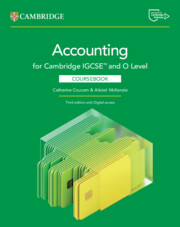Cambridge IGCSE™ and O Level Accounting Digital Coursebook (2 Years)
Overview
This coursebook will help your students build an understanding of key accounting concepts, with engaging imagery and examples in practice to ensure topics are accessible for all students. Engage your students with a variety of activities to encourage active learning, from writing and presenting a short speech to preparing a statement of financial position. Students will explore the importance of accounting for businesses and individuals, through topics such as double entry bookkeeping, financial statements and the correction of errors. Key term definitions in the digital version of the coursebook provide additional support for students with English as an additional language.
Features
- Varied activities, such as calculating estimated cost of production, encourage active learning and provide formative assessment insights.
- 'Learning intentions' aligned with the learning objectives provide focus and structure for what students will learn in each chapter.
- Examples of accounting in practice help to engage students and contextualise subject-specific vocabulary to aid understanding.
- 'Accounting in context' feature enables students to discuss examples in practice to help them understand key topics, such as discussing the importance of keeping accurate records of business transactions.
- Worked examples demonstrate the process of a specific task, offering an ideal problem-solving structure to support students.
- Discussion questions help students explore topics in more depth and build their understanding in pairs or groups.
- 'Accounting in action' feature allows students to investigate accounting in practice, such as the impact of lost or damaged accounting records, or methods of raising funds.
- Key term definitions and concept links provide additional support throughout each chapter.
- 'Check your progress' feature and practice questions enable students to keep track of their learning and prepare for assessment.
- Tips are included throughout each chapter offering strategies to help students develop their accounting skills.
- Accessibility Information: This publication meets the requirements of the EPUB Accessibility specification with conformance to WCAG 2.2 Level AA.
Contents
- Introduction
- How to use this book
- Acknowledgements
- Section 1. Chapter 1. Introduction to accounting
- Chapter 2. Double entry book-keeping Part A
- Chapter 3. The trial balance
- Chapter 4. Double entry book-keeping Part B
- Chapter 5. Petty cash books
- Section 1 practice questions
- Section 2. Chapter 6. Business documents
- Chapter 7. Books of prime entry
- Section 2 practice questions
- Section 3. Chapter 8. Financial statements Part A
- Chapter 9. Financial statements Part B
- Chapter 10. Accounting rules
- Chapter 11. Other payables and other receivables
- Chapter 12. Accounting for depreciation and disposal of non-current assets
- Chapter 13. Irrecoverable debts and allowance for irrecoverable debts
- Section 3 practice questions
- Section 4. Chapter 14. Bank reconciliation statements
- Chapter 15. Journal entries and correction of errors
- Chapter 16. Control accounts
- Chapter 17. Incomplete records
- Chapter 18. Accounts of non-trading organisations (clubs and societies)
- Chapter 19. Partnerships
- Chapter 20. Manufacturing accounts
- Chapter 21. Limited companies
- Chapter 22. Analysis and interpretation
- Chapter 23. Technology and sustainability Section 4 practice questions
- Glossary
- Appendix
- Index.
Brighter Thinking Blog
Keep up to date with the latest classroom tips and educational trends from our brighter thinkers.
Visit the blogCatalogues and Ordering
Looking for something in particular or just browsing? View our catalogues to see our full range of print and digital books.
View and downloadAdvice on useful tools
Advice on useful tools, activities and timetabling from teachers experiencing school closures.
Cambridge GO
All our supporting resources have now moved to Cambridge GO – the new home for your Cambridge digital content.
Listen to our podcast
Listen to our podcast to discover teaching inspiration & advice from leading educational thinkers.






